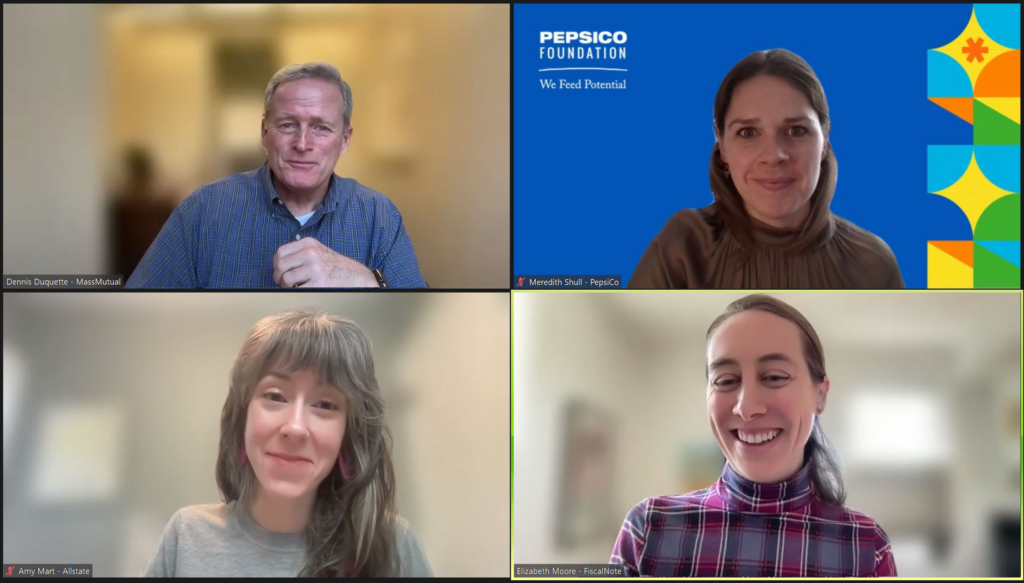Key Takeaways:
-
- Set realistic expectations: Putting concrete numbers on social impact investments is a challenge for many in the CSR space, and it’s essential that you communicate limitations with your leadership team.
- Prove value both internally and externally: For example, one leader suggested working with internal teams to pull data on how social impact influences employee experience.
- Speak in the C-suite’s language: Use phrases that resonate with them. Terms that are common in academic research may not land in a corporate setting.
- Be cautious about causal attribution: It’s essential that you and your partners have the data you need, but not necessarily for the goal of taking credit for positive changes.
When proving the value of your community investments, stakeholders often want you to put concrete numbers on outcomes. But philanthropy isn’t a business, and measuring how much change each dollar you spend makes in the world is nearly impossible.
Yet, that won’t stop some executives from asking for the data, and as a corporate social responsibility (CSR) leader, you still need to demonstrate your program’s importance.
How can you communicate these reporting limitations and set realistic expectations with your leadership team?
Three senior corporate philanthropy leaders from the MassMutual, PepsiCo, and Allstate Foundations recently came together for an ESG & CSR Board panel where they discussed how they’ve tackled this crucial work.
Proving your impact externally and internally
Dennis Duquette, MassMutual Foundation CEO and Head of Community Responsibility emphasized the need to prove the influence of your philanthropic investments, both internally and externally.
“We all have a case to be made to senior leaders about the impact of the work we do,” Dennis said. “Certainly outside of our four walls, but also within.”
At MassMutual, Dennis shared that executives are keyed into how this community work impacts employee experience, and this is an area where they can reasonably extract metrics.
“We all have a case to be made to senior leaders about the impact of the work we do.”
– Dennis Duquette, MassMutual Foundation CEO and Head of Community Responsibility
At your company, you likely already have internal processes to gather data on employee retention, satisfaction, etc. So, if you’re struggling to put concrete numbers on your community investments, looking internally at how they impact employee experience could be a good starting point.
“Being able to get under the hood on some of those things is a little easier, because you can lean on folks within the organization who can help you ascertain that information,” Dennis shared.
Effectively communicating with leadership
Being in the financial services industry, Dennis certainly operates in an environment that favors numbers, but he said it’s incumbent upon him to be realistic with leadership on the types of social impact metrics they can deliver.

Aligning with leadership on these expectations really hinges on strong and consistent communication. He said it’s critical that you’re upfront with executives about your goals and limitations and that you provide them with the opportunity to ask questions.
During a confidential conversation with ESG & CSR Board members earlier this year, one member with deep expertise in developing impact data strategies said to be sure to use language that resonates with execs in your sector.
For instance, they shared that when discussing one of their education initiatives, the term “consumer activation” got leadership’s attention because it made sense to them. In contrast, when they used the phrase “community awareness,” which is more typical in academic studies, they got crickets.
Important considerations regarding causal attribution
Amy Mart, who leads Social Impact Measurement and Evaluation at the Allstate Foundation, also highlighted the importance of using the right language related to causal attribution.
They’re focused on three major social impact initiatives involving closing the racial opportunity gap in the workforce, reducing the prevalence of relationship abuse, and empowering young people to create positive change in their communities.
They’ve operationalized those statements using publicly available population-level data that allows them to see if the needle is moving in a positive direction.
“I’m careful how I say that,” Amy noted. “It’s not necessarily ‘are we moving the needle?’ but ‘is the needle moving on those issues at scale over time?'”
She explained that while they do want to ensure both Allstate and their partners have access to data that allows them to maximize their impact, she isn’t sure it behooves the company to invest energy into taking credit for these outcomes.
“It’s not necessarily ‘are we moving the needle?’ but ‘is the needle moving on those issues at scale over time?'”
– Amy Mart, Head of Social Impact Measurement, Evaluation, and Thought Leadership at The Allstate Foundation
Dennis echoed this sentiment saying, “We are contributing to something, we are not solving something all by ourselves.”
As a result, Amy said the team is more focused on refining their approaches and making smarter investments centered on the needs of their beneficiaries.
“But it’s less so about trying to say that we know for certain this investment caused this positive change in outcome,” Amy said.
Social impact investments and reporting don’t happen overnight
During the ESG & CSR Board’s confidential conversation, one member asked, “How do you get leaders to care about outcomes over outputs? Do others struggle with this?”
The short answer was yes, many CSR leaders that day could relate to this member’s experience with leadership preferring the short-term, flashier numbers you get by measuring outputs over the longer-term, harder-to-get, and typically much smaller quantity of outcomes.
Another member suggested presenting data in a way that gets leaders asking insightful questions, which can develop their appetite for the kinds of insights better measurement of outcomes and impacts can provide.
During the panel discussion, Meredith Shull, Monitoring, Evaluation, and Learning Manager at the PepsiCo Foundation, said a lot of leadership does appreciate the need for this kind of work and may be aware of the obstacles along the way.
You need to communicate that these initiatives are accomplished over time.
“It’s really important to remember this is a journey,” Meredith said.
“This is where a theory of change can be a really useful tool, so we can say this is what we want to achieve, and this is our theory of how we will get there.”
– Meredith Shull, Monitoring, Evaluation, and Learning Manager at the PepsiCo Foundation
The benefits of using theories of change were also discussed confidentially by ESG & CSR Board members.
One member shared that while better alignment with leadership on impact data would be ideal — and they hope to eventually achieve it — they’ve also been able to make it work by partnering with university classes to develop research theories of change to drive their data modeling.
Overall, members agreed that most CSR leaders are working in imperfect situations, but the important thing is that they keep working.
Benchmarking social impact measurement with your peers
When discussing impact reporting, one ESG & CSR Board member strongly recommended culling the landscape for metrics that others are already using and seeing if you can connect to other philanthropy leaders in your same space about how they are measuring.
Not only can this help you get ahead by learning from others, but you’ll also be aligning with metrics your partners may already be set up to measure and provide.
It’s clear that benchmarking with your peers is an invaluable tool if you’re leading social impact at a large enterprise, learn how you could join your peers in the ESG & CSR Board.


